 The Two Micron All Sky Survey at IPAC
The Two Micron All Sky Survey at IPAC
![]()
 The Two Micron All Sky Survey at IPAC
The Two Micron All Sky Survey at IPAC
|
|
|
The galactic open cluster, the Pleiades (Messier 45).
Mosaic image construction by E. Kopan (IPAC).
(Field size 0.56° × 0.59°. Image size 2.6 Mb!)
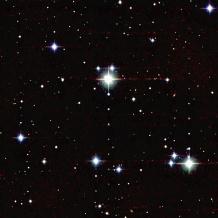
The galactic open cluster, Praesepe (Messier 44).
(Field size 20.0´ × 20.0´. Image size 3.2 Mb!)
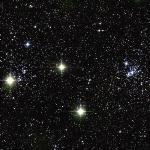
Atlas Image mosaic of the famous Double Cluster,
h+ Persei, aka NGC 869 and NGC 884,
respectively.
From wide-field optical photometry of the stars in these two open clusters,
Keller et al. (2001, AJ, 122, 248) recently found that both clusters share
a common distance of about 2.2 kpc (or 7300 light years) from us. The central
regions of both clusters have an average extinction of nearly 1.7 visual
magnitudes (the reddening is highly variable across the field). With this
information Keller et al. find that the clusters also share a common age
of about 12.6 Myr. This determination of age, distance, and extinction for
the two clusters (similar values were also recently found by Marco & Bernabeu
2001, A&A, 372, 477) is consistent with what is seen in
the 2MASS near-infrared
color-color and color-magnitude
diagrams. (The green line on the 2MASS color-magnitude diagram is the 12.6
Myr solar-metallicity isochrone; the two other features are stars
in the field not associated with the double cluster.) Purplish known
persistence artifacts trail (in decreasing brightness) either due north or
due south (or both!) from the brightest stars in the 2MASS image.
Image mosaic by S. Van Dyk (IPAC).
(Field size 48´ × 48´. Image size 6.5 Mb!)
Persei, aka NGC 869 and NGC 884,
respectively.
From wide-field optical photometry of the stars in these two open clusters,
Keller et al. (2001, AJ, 122, 248) recently found that both clusters share
a common distance of about 2.2 kpc (or 7300 light years) from us. The central
regions of both clusters have an average extinction of nearly 1.7 visual
magnitudes (the reddening is highly variable across the field). With this
information Keller et al. find that the clusters also share a common age
of about 12.6 Myr. This determination of age, distance, and extinction for
the two clusters (similar values were also recently found by Marco & Bernabeu
2001, A&A, 372, 477) is consistent with what is seen in
the 2MASS near-infrared
color-color and color-magnitude
diagrams. (The green line on the 2MASS color-magnitude diagram is the 12.6
Myr solar-metallicity isochrone; the two other features are stars
in the field not associated with the double cluster.) Purplish known
persistence artifacts trail (in decreasing brightness) either due north or
due south (or both!) from the brightest stars in the 2MASS image.
Image mosaic by S. Van Dyk (IPAC).
(Field size 48´ × 48´. Image size 6.5 Mb!)
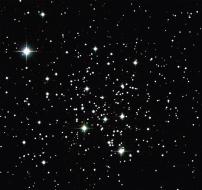
The old open cluster Messier 67, featuring the famous "dipper
asterism". (Field size 15´ × 15´. Image size 320 kb.)
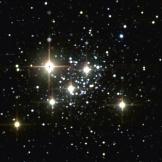 NGC 7419, a heavily-reddened Cepheus open star cluster.
The cluster in the near-IR is highlighted by the five bright red supergiants.
Beauchamp, Moffat, & Drissen (1994, ApJS, 93, 187) derived an age of
14 ± 2 million yr and a distance of 2.3 kpc from
theoretical evolutionary tracks, and found that the cluster is dynamically
relaxed.
Beauchamp et al. also found that there is at most one blue supergiant member,
which contradicts theoretical expectations. The brightest star in the
2MASS image is the M7.5 OH/IR star MY Cephei.
The yellowish bright star to the southeast is the carbon star MZ Cephei, which
has Ks=3.7, J-H~1.7, H-K~1.6.
The red "stars" just to the northeast of the brightest stars are filter glint
artifacts, and the "fuzzy" bluish "stars" due north of these bright stars are
array persistence ("ghost") artifacts. (Field size
8.3´ × 8.4´. Image size 213 kb.)
NGC 7419, a heavily-reddened Cepheus open star cluster.
The cluster in the near-IR is highlighted by the five bright red supergiants.
Beauchamp, Moffat, & Drissen (1994, ApJS, 93, 187) derived an age of
14 ± 2 million yr and a distance of 2.3 kpc from
theoretical evolutionary tracks, and found that the cluster is dynamically
relaxed.
Beauchamp et al. also found that there is at most one blue supergiant member,
which contradicts theoretical expectations. The brightest star in the
2MASS image is the M7.5 OH/IR star MY Cephei.
The yellowish bright star to the southeast is the carbon star MZ Cephei, which
has Ks=3.7, J-H~1.7, H-K~1.6.
The red "stars" just to the northeast of the brightest stars are filter glint
artifacts, and the "fuzzy" bluish "stars" due north of these bright stars are
array persistence ("ghost") artifacts. (Field size
8.3´ × 8.4´. Image size 213 kb.)
 The open cluster Messier 6. (Field size
16.7´ × 16.7´. Image size 2.0 Mb!)
The open cluster Messier 6. (Field size
16.7´ × 16.7´. Image size 2.0 Mb!)
 The open cluster Messier 7. (Field size
15.0´ × 15.0´. Image size 2.8 Mb!)
The open cluster Messier 7. (Field size
15.0´ × 15.0´. Image size 2.8 Mb!)
 Atlas Image mosaic of the galactic open
star cluster Messier 11 (M11), also known as the Wild Duck.
M11 (NGC 6705) is one of the more populous and
compact open clusters in the Milky Way, close to the Galactic plane
(l=27.3°, b = -2.8°) toward the constellation Scutum.
From an analysis of deep optical CCD photometry of
the cluster, Brocato, Castellani, & DiGiogio (1993, AJ, 105, 2192) determined
that the stars are at a distance of 1.7 kpc (5542 light years) from us and
have an age of ~150 million years, making the cluster intermediate in age.
Solomon & McNamara (1980, AJ, 85, 432) estimated the reddening to the cluster
to be E(B-V)~0.42 mag. 2MASS has obtained near-infrared photometry for the
cluster during routine operations; to see the color-color diagram, click
here, and to see the color-magnitude diagram,
click here. In the latter diagram, we overlay a
theoretical isochrone at solar metallicity (Gonzales & Wallerstein 2000, PASP,
112, 1081) with age 150 Myr (green line), showing that the assumed age,
distance, and reddening are consistent with the main sequence and red giant
stars in M11. The blue line indicates contamination due primarily
to older giants in the foreground and background; the isochrone is solar age
at 1 kpc distance with the same reddening. Image mosaic by S. Van Dyk (IPAC).
(Field size 10.0´ × 10.0´. Image size 385 kb.)
Atlas Image mosaic of the galactic open
star cluster Messier 11 (M11), also known as the Wild Duck.
M11 (NGC 6705) is one of the more populous and
compact open clusters in the Milky Way, close to the Galactic plane
(l=27.3°, b = -2.8°) toward the constellation Scutum.
From an analysis of deep optical CCD photometry of
the cluster, Brocato, Castellani, & DiGiogio (1993, AJ, 105, 2192) determined
that the stars are at a distance of 1.7 kpc (5542 light years) from us and
have an age of ~150 million years, making the cluster intermediate in age.
Solomon & McNamara (1980, AJ, 85, 432) estimated the reddening to the cluster
to be E(B-V)~0.42 mag. 2MASS has obtained near-infrared photometry for the
cluster during routine operations; to see the color-color diagram, click
here, and to see the color-magnitude diagram,
click here. In the latter diagram, we overlay a
theoretical isochrone at solar metallicity (Gonzales & Wallerstein 2000, PASP,
112, 1081) with age 150 Myr (green line), showing that the assumed age,
distance, and reddening are consistent with the main sequence and red giant
stars in M11. The blue line indicates contamination due primarily
to older giants in the foreground and background; the isochrone is solar age
at 1 kpc distance with the same reddening. Image mosaic by S. Van Dyk (IPAC).
(Field size 10.0´ × 10.0´. Image size 385 kb.)
 The open cluster Messier 21. (Field size
22.0´ × 25.0´. Image size 1.9 Mb!)
The open cluster Messier 21. (Field size
22.0´ × 25.0´. Image size 1.9 Mb!)
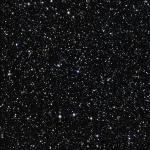 The open cluster Messier 23. (Field size
20´ × 22.5´. Image size 443 kb.)
The open cluster Messier 23. (Field size
20´ × 22.5´. Image size 443 kb.)
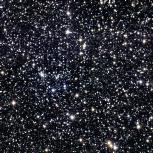 The open cluster Messier 26. (Field size
14.0´ × 20.0´. Image size 987 kb.)
The open cluster Messier 26. (Field size
14.0´ × 20.0´. Image size 987 kb.)
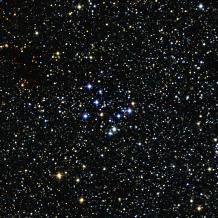 The open cluster Messier 29. (Field size
20.0´ × 20.0´. Image size 5.8 Mb!)
The open cluster Messier 29. (Field size
20.0´ × 20.0´. Image size 5.8 Mb!)
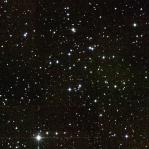 The open cluster Messier 34. (Field size
19.9´ × 23.7´. Image size 1.5 Mb!)
The open cluster Messier 34. (Field size
19.9´ × 23.7´. Image size 1.5 Mb!)
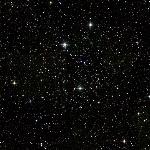 The open cluster Messier 35. (Field size
50´ × 40´. Image size 5.1 Mb!)
The open cluster Messier 35. (Field size
50´ × 40´. Image size 5.1 Mb!)
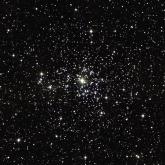 The intermediate-age open cluster Messier 37. (Field size
11.0´ × 12.3´. Image size 419 kb.)
The intermediate-age open cluster Messier 37. (Field size
11.0´ × 12.3´. Image size 419 kb.)
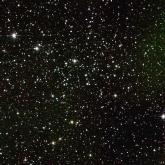 The open cluster Messier 38. (Field size
11.0´ × 14.6´. Image size 569 kb.)
The open cluster Messier 38. (Field size
11.0´ × 14.6´. Image size 569 kb.)
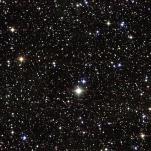 The open cluster Messier 39. (Field size
22.5´ × 31.5´. Image size 2.2 Mb!)
The open cluster Messier 39. (Field size
22.5´ × 31.5´. Image size 2.2 Mb!)
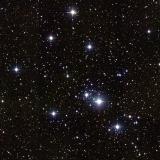 The open cluster Messier 41. (Field size
0.49° × 0.66°. Image size 3.8 Mb!)
The open cluster Messier 41. (Field size
0.49° × 0.66°. Image size 3.8 Mb!)
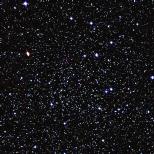 The open cluster Messier 46. (Field size
0.43° × 0.46°. Image size 2.5 Mb!)
The open cluster Messier 46. (Field size
0.43° × 0.46°. Image size 2.5 Mb!)
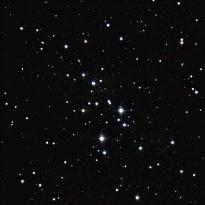 The open cluster Messier 48. (Field size
0.30° × 0.41°. Image size 1.1 Mb!)
The open cluster Messier 48. (Field size
0.30° × 0.41°. Image size 1.1 Mb!)
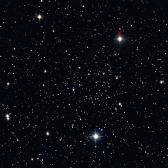 The open cluster Messier 50. (Field size
0.37° × 0.42°. Image size 1.4 Mb!)
The open cluster Messier 50. (Field size
0.37° × 0.42°. Image size 1.4 Mb!)
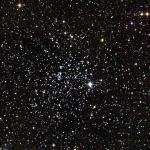 The open cluster Messier 52. (Field size
20.0´ × 25.0´. Image size 1.6 Mb!)
The open cluster Messier 52. (Field size
20.0´ × 25.0´. Image size 1.6 Mb!)
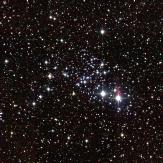 The open cluster Messier 93. (Field size
17.0´ × 17.0´. Image size 1.0 Mb!)
The open cluster Messier 93. (Field size
17.0´ × 17.0´. Image size 1.0 Mb!)
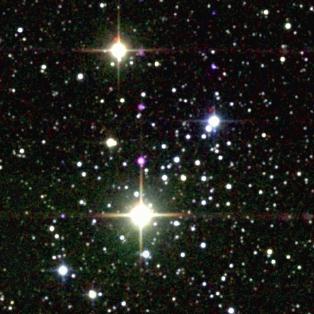 Atlas Image Mosaic of the open star cluster
Messier 103 (NGC 581). Sanner et al. (1999, A&A, 349, 448) find, from
optical
photometry of stars in M103, that the cluster is at a distance of about 2900
pc (9450 light years), behind a bit more than a magnitude of visual extinction,
and formed about 16 million years ago. Their analysis indicates that the
so-called initial mass function for the cluster may be somewhat steeper
generally than other open star clusters. The purplish "stars" trailing
northward from the brightest stars in the 2MASS image are known persistence
artifacts; diffraction spike artifacts are also seen around these bright stars.
Click here to obtain a 2MASS color-color diagram
for M103; the cyan line is the dwarf stellar track, the red line
is the giant track (Bessell & Brett 1988, PASP, 100, 1134).
Click here to obtain the
color-magnitude diagram; the theoretical isochrone (in green) agrees
with the optically-derived distance, extinction, and age for the cluster.
Image mosaic by S. Van Dyk (IPAC).
(Field size 8.0´ × 12.0´. Image size 351 kb.)
Atlas Image Mosaic of the open star cluster
Messier 103 (NGC 581). Sanner et al. (1999, A&A, 349, 448) find, from
optical
photometry of stars in M103, that the cluster is at a distance of about 2900
pc (9450 light years), behind a bit more than a magnitude of visual extinction,
and formed about 16 million years ago. Their analysis indicates that the
so-called initial mass function for the cluster may be somewhat steeper
generally than other open star clusters. The purplish "stars" trailing
northward from the brightest stars in the 2MASS image are known persistence
artifacts; diffraction spike artifacts are also seen around these bright stars.
Click here to obtain a 2MASS color-color diagram
for M103; the cyan line is the dwarf stellar track, the red line
is the giant track (Bessell & Brett 1988, PASP, 100, 1134).
Click here to obtain the
color-magnitude diagram; the theoretical isochrone (in green) agrees
with the optically-derived distance, extinction, and age for the cluster.
Image mosaic by S. Van Dyk (IPAC).
(Field size 8.0´ × 12.0´. Image size 351 kb.)
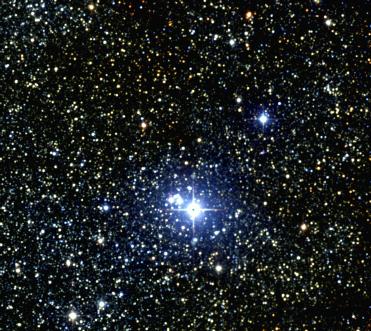 Atlas Image mosaic of the heavily reddened young open cluster Trumpler
27. This relatively unstudied cluster
lies about 5° from the Galactic Center at a distance of 1.65 kpc from us
(Bakker & The 1983, A&AS, 52, 27), behind a visual extinction of 4 mag or more.
The brightest star in the 2MASS image is a M0 supergiant; the next brightest
star, to the northwest, is thought to be a Cepheid variable, due to its
proximity to the instability strip on the H-R Diagram. The bright reddish star
to the northeast of the image center is a WC9 Wolf-Rayet star with a very large
infrared excess, due to thermal reemission of the star's ultraviolet photons
by dust grains local to the star. The cluster, however, is dominated by young,
massive O- and B-type main sequence stars. An optical photometric estimate
of the cluster's age is about 107 yr (Battinelli et al. 1994,
A&AS, 104, 379).
(Field size 15.3´ × 13.6´. Image size 716 kb.)
Atlas Image mosaic of the heavily reddened young open cluster Trumpler
27. This relatively unstudied cluster
lies about 5° from the Galactic Center at a distance of 1.65 kpc from us
(Bakker & The 1983, A&AS, 52, 27), behind a visual extinction of 4 mag or more.
The brightest star in the 2MASS image is a M0 supergiant; the next brightest
star, to the northwest, is thought to be a Cepheid variable, due to its
proximity to the instability strip on the H-R Diagram. The bright reddish star
to the northeast of the image center is a WC9 Wolf-Rayet star with a very large
infrared excess, due to thermal reemission of the star's ultraviolet photons
by dust grains local to the star. The cluster, however, is dominated by young,
massive O- and B-type main sequence stars. An optical photometric estimate
of the cluster's age is about 107 yr (Battinelli et al. 1994,
A&AS, 104, 379).
(Field size 15.3´ × 13.6´. Image size 716 kb.)
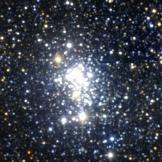 Atlas Image mosaic of the compact open cluster
Westerlund 1. The cluster is located in the southern Milky Way in Ara and is
heavily reddened, behind nearly 13 magnitudes of visual extinction (Piatti,
Bica, & Claria 1997, A&AS, 127, 423), making it one of the most reddened known
open clusters in the Milky Way Galaxy. Piatti et al., from optical
photometry, determined that this massive cluster is at a distance of about 1.1
kpc (nearly 3600 light years), contains several intrinsically luminous stars,
and has an age of about 8 Myr. Image mosaic by S. Van Dyk (IPAC).
(Field size 13.0´ × 13.0´. Image size 529 kb.)
Atlas Image mosaic of the compact open cluster
Westerlund 1. The cluster is located in the southern Milky Way in Ara and is
heavily reddened, behind nearly 13 magnitudes of visual extinction (Piatti,
Bica, & Claria 1997, A&AS, 127, 423), making it one of the most reddened known
open clusters in the Milky Way Galaxy. Piatti et al., from optical
photometry, determined that this massive cluster is at a distance of about 1.1
kpc (nearly 3600 light years), contains several intrinsically luminous stars,
and has an age of about 8 Myr. Image mosaic by S. Van Dyk (IPAC).
(Field size 13.0´ × 13.0´. Image size 529 kb.)
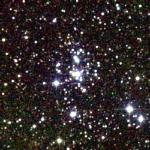 Atlas Image of the southern open star
cluster Collinder 205 (aka Markarian 18). Vogt & Moffat (1973, A&AS,
9, 97) found from optical photometry that the reddening to this cluster varied
from about 1.8 to 2.8 visual magnitudes, that the cluster's distance is about
1.6 kpc (5216 light years), and that the earliest spectral type in the cluster
is B1. Reed (2000, AJ, 119, 1855) recently included this cluster with the much
larger association Vela OB1.
(Field size 6.7´ × 6.7´. Image size 209 kb.)
Atlas Image of the southern open star
cluster Collinder 205 (aka Markarian 18). Vogt & Moffat (1973, A&AS,
9, 97) found from optical photometry that the reddening to this cluster varied
from about 1.8 to 2.8 visual magnitudes, that the cluster's distance is about
1.6 kpc (5216 light years), and that the earliest spectral type in the cluster
is B1. Reed (2000, AJ, 119, 1855) recently included this cluster with the much
larger association Vela OB1.
(Field size 6.7´ × 6.7´. Image size 209 kb.)
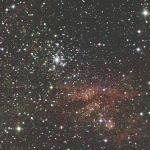 Atlas Image mosaic of the open cluster IC 1590, which
centers around the Trapezium-like system, HD 5005 (the bright blue
object north of image center). The cluster is associated with, and generally
embedded in, the nebula NGC 281 (Sharpless 184). Guetter & Turner (1997, AJ,
113, 2116) performed detailed optical photometry and spectroscopy, and limited
K-band photometry, of stars in the cluster and found the distance of 2.9 kpc
(9450 light years) to the optically-visible cluster, behind nearly 2
visual magnitudes of extinction. They find the cluster to be quite young,
~3.5 Myr. What is most remarkable is that, comparing an optical image of
NGC 281
with the 2MASS image, what are dark regions of dust in the optical nebula are
bright regions of dust and molecular gas emission in the near-infrared. More
importantly, deeply embedded newly-forming stars are evident, to the southwest
of the optical cluster (additional star formation appears to be occurring to
the east as well). The 2MASS color-color and
color-magnitude diagrams for both clusters show
that the age, distance, and reddening are consistent for the stars around
HD 5005 (green tracks on the diagrams), but the more embedded, probably very
young objects are behind up to ~15 visual magnitudes of extinction.
(Field size 28´ × 28´. Image size 2.7 Mb!)
Atlas Image mosaic of the open cluster IC 1590, which
centers around the Trapezium-like system, HD 5005 (the bright blue
object north of image center). The cluster is associated with, and generally
embedded in, the nebula NGC 281 (Sharpless 184). Guetter & Turner (1997, AJ,
113, 2116) performed detailed optical photometry and spectroscopy, and limited
K-band photometry, of stars in the cluster and found the distance of 2.9 kpc
(9450 light years) to the optically-visible cluster, behind nearly 2
visual magnitudes of extinction. They find the cluster to be quite young,
~3.5 Myr. What is most remarkable is that, comparing an optical image of
NGC 281
with the 2MASS image, what are dark regions of dust in the optical nebula are
bright regions of dust and molecular gas emission in the near-infrared. More
importantly, deeply embedded newly-forming stars are evident, to the southwest
of the optical cluster (additional star formation appears to be occurring to
the east as well). The 2MASS color-color and
color-magnitude diagrams for both clusters show
that the age, distance, and reddening are consistent for the stars around
HD 5005 (green tracks on the diagrams), but the more embedded, probably very
young objects are behind up to ~15 visual magnitudes of extinction.
(Field size 28´ × 28´. Image size 2.7 Mb!)
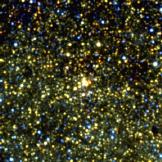 Atlas Image of the Quintuplet star cluster
near the Galactic Center. The Quintuplet is a young (~4 Myr old), very massive
cluster of stars, formed during one of the recent bursts of star formation
around the Milky Way's center. The cluster, seen behind about 29 magnitudes of
visual extinction, actually consists of more than just five stars.
The five bright stars that earned the cluster its name, however, have high
luminosities in the near-infrared and are likely young, dust-enshrouded stars.
Figer, McLean, & Morris (1999, ApJ, 514, 202) recently produced a census of
the massive stars in the cluster, based on near-infrared photometry and
spectroscopy. In addition to O- and B-type main-sequence and supergiant
stars, a number of post-main-sequence decendants of massive stars, i.e.,
several Wolf-Rayet stars and Luminous Blue Variables (LBVs), have also been
identified. The most famous of these LBVs is the
Pistol Star (seen ~0.5´ due south of the main cluster in the center of
the 2MASS image), imaged recently with HST/NICMOS and studied by Figer
et al. (1998, ApJ, 506, 384).
The Pistol Star appears to have 100-200 times the mass of the Sun, making it
one of the most massive and luminous stars in the Milky Way!
Considering the mass and number densities of stars in the cluster, the
Quintuplet, also recently imaged with
NICMOS, can be considered a small "super star cluster," examples of
which are found in starbursts occurring in many other galaxies. Super star
clusters are thought to be young globular clusters in the making.
These data are included in the Second Incremental Release!
(Field size 6.0´ × 6.0´. Image size 171 kb.)
Atlas Image of the Quintuplet star cluster
near the Galactic Center. The Quintuplet is a young (~4 Myr old), very massive
cluster of stars, formed during one of the recent bursts of star formation
around the Milky Way's center. The cluster, seen behind about 29 magnitudes of
visual extinction, actually consists of more than just five stars.
The five bright stars that earned the cluster its name, however, have high
luminosities in the near-infrared and are likely young, dust-enshrouded stars.
Figer, McLean, & Morris (1999, ApJ, 514, 202) recently produced a census of
the massive stars in the cluster, based on near-infrared photometry and
spectroscopy. In addition to O- and B-type main-sequence and supergiant
stars, a number of post-main-sequence decendants of massive stars, i.e.,
several Wolf-Rayet stars and Luminous Blue Variables (LBVs), have also been
identified. The most famous of these LBVs is the
Pistol Star (seen ~0.5´ due south of the main cluster in the center of
the 2MASS image), imaged recently with HST/NICMOS and studied by Figer
et al. (1998, ApJ, 506, 384).
The Pistol Star appears to have 100-200 times the mass of the Sun, making it
one of the most massive and luminous stars in the Milky Way!
Considering the mass and number densities of stars in the cluster, the
Quintuplet, also recently imaged with
NICMOS, can be considered a small "super star cluster," examples of
which are found in starbursts occurring in many other galaxies. Super star
clusters are thought to be young globular clusters in the making.
These data are included in the Second Incremental Release!
(Field size 6.0´ × 6.0´. Image size 171 kb.)
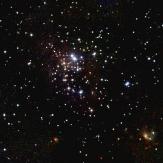 Atlas Image mosaic of the young open cluster IC 348.
This cluster, at a distance of ~320 pc, is still embedded in its parental
molecular gas cloud, which is part of the larger Perseus Molecular Cloud.
Thus, many of the cluster members are obscured by dust and would go
relatively undetected in optical imaging of the cluster. For such very young
embedded clusters as IC 348, near-infrared imaging, such as by 2MASS, provides
a more complete stellar census and determination of the stellar and cluster
properties and histories. The bright star near the top center of the 2MASS image mosaic is
omicron Persei. The main portion of IC 348 is toward the image mosaic center,
just south of the star. From their JHK imaging, Lada & Lada (1995, AJ, 109, 1682) found
~380 members of the cluster, that the stellar density is consistent with
other rich embedded clusters, and that ~20% of the members are infrared-excess
objects, suggesting the presence of circumstellar disks.
For a near-infrared color-color diagram for sources in the IC 348 field drawn
from the release Point Source Catalog, click
here. Image mosaic by S. Van Dyk (IPAC).
These data are included in the Second Incremental Release!
(Field size 23.3´ × 20.0´. Image size 1.5 Mb!)
Atlas Image mosaic of the young open cluster IC 348.
This cluster, at a distance of ~320 pc, is still embedded in its parental
molecular gas cloud, which is part of the larger Perseus Molecular Cloud.
Thus, many of the cluster members are obscured by dust and would go
relatively undetected in optical imaging of the cluster. For such very young
embedded clusters as IC 348, near-infrared imaging, such as by 2MASS, provides
a more complete stellar census and determination of the stellar and cluster
properties and histories. The bright star near the top center of the 2MASS image mosaic is
omicron Persei. The main portion of IC 348 is toward the image mosaic center,
just south of the star. From their JHK imaging, Lada & Lada (1995, AJ, 109, 1682) found
~380 members of the cluster, that the stellar density is consistent with
other rich embedded clusters, and that ~20% of the members are infrared-excess
objects, suggesting the presence of circumstellar disks.
For a near-infrared color-color diagram for sources in the IC 348 field drawn
from the release Point Source Catalog, click
here. Image mosaic by S. Van Dyk (IPAC).
These data are included in the Second Incremental Release!
(Field size 23.3´ × 20.0´. Image size 1.5 Mb!)
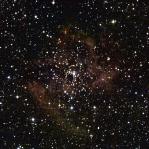 Atlas Image mosaic of the open star cluster
IC 5146. This cluster was identified by Walker (1959, ApJ, 130, 57)
as extremely young. The 2MASS image peers through the dusty nebulosity seen
around this cluster in the optical, revealing many more stars. Forte &
Orsatti (1984, ApJS, 56, 211) identified ~110 members from optical plates;
they found a reddening to the stars of ~3-4 visual magnitudes, and concluded
that the objects most embedded in the nebulosity are protostellar, with ages
no more than 1-3 Myr. The extinction is likely at least 10 visual magnitudes
or more, with a distance to the cluster of at least 460 pc (1500 light years;
Kramer et al. 1998, A&A, 342, 257), if not 1 kpc or more (Forte & Orsatti 1984).
Click here for a 2MASS color-color diagram of
IC 5146. Image mosaic by S. Van Dyk (IPAC).
(Field size 17.0´ × 17.0´. Image size 938 kb.)
Atlas Image mosaic of the open star cluster
IC 5146. This cluster was identified by Walker (1959, ApJ, 130, 57)
as extremely young. The 2MASS image peers through the dusty nebulosity seen
around this cluster in the optical, revealing many more stars. Forte &
Orsatti (1984, ApJS, 56, 211) identified ~110 members from optical plates;
they found a reddening to the stars of ~3-4 visual magnitudes, and concluded
that the objects most embedded in the nebulosity are protostellar, with ages
no more than 1-3 Myr. The extinction is likely at least 10 visual magnitudes
or more, with a distance to the cluster of at least 460 pc (1500 light years;
Kramer et al. 1998, A&A, 342, 257), if not 1 kpc or more (Forte & Orsatti 1984).
Click here for a 2MASS color-color diagram of
IC 5146. Image mosaic by S. Van Dyk (IPAC).
(Field size 17.0´ × 17.0´. Image size 938 kb.)
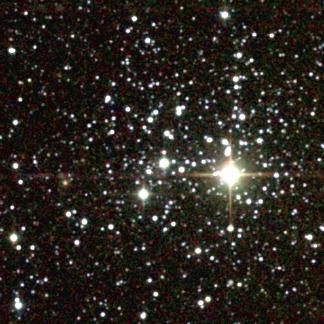 The open star cluster NGC 2194.
(Field size 8.2´ × 11.7´. Image size 374 kb.)
The open star cluster NGC 2194.
(Field size 8.2´ × 11.7´. Image size 374 kb.)
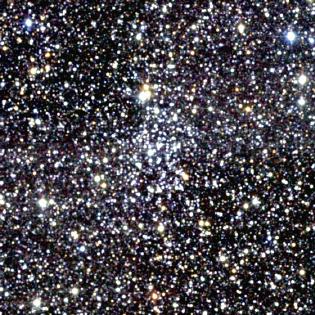 The open star cluster NGC 6802.
(Field size 11.7´ × 11.7´. Image size 583 kb.)
The open star cluster NGC 6802.
(Field size 11.7´ × 11.7´. Image size 583 kb.)
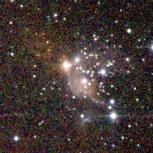 Atlas Image Mosaic of the star cluster NGC 7129.
Star formation is still occurring in this young cluster. The bright reddish
embedded star northeast of the image center is the Herbig Ae/Be star
LkH
Atlas Image Mosaic of the star cluster NGC 7129.
Star formation is still occurring in this young cluster. The bright reddish
embedded star northeast of the image center is the Herbig Ae/Be star
LkH 234, which is a source of molecular outflows. Farther
to the northeast is the Herbig-Haro object HH 105. The various other knots and
filaments are also indicative of outflow from the cluster stars (Eisloffel 2000,
A&A, 354, 236). A long snake-like bright filament can be seen running along
the southeast of the cluster. Emission from this filament, seen particularly
at 2.12 µm (in the Ks band), appears to be due to flourescence,
excited by LkH
234, which is a source of molecular outflows. Farther
to the northeast is the Herbig-Haro object HH 105. The various other knots and
filaments are also indicative of outflow from the cluster stars (Eisloffel 2000,
A&A, 354, 236). A long snake-like bright filament can be seen running along
the southeast of the cluster. Emission from this filament, seen particularly
at 2.12 µm (in the Ks band), appears to be due to flourescence,
excited by LkH 234 (Noriega-Crespo et al. 2001, in
preparation). A curious-looking possible outflow object can also be seen to
the south of the star cluster. Image mosaic by S. Van Dyk (IPAC).
(Field size 7.0´ × 7.0´. Image size 216 kb.)
234 (Noriega-Crespo et al. 2001, in
preparation). A curious-looking possible outflow object can also be seen to
the south of the star cluster. Image mosaic by S. Van Dyk (IPAC).
(Field size 7.0´ × 7.0´. Image size 216 kb.)
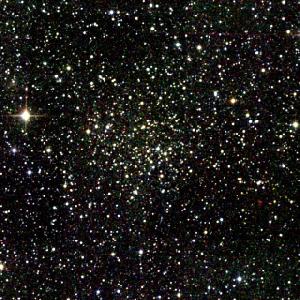 Atlas Image mosaic of a previously-unknown
old open star cluster near the Galactic Plane, uncovered by J.D.
Kirkpatrick
during the quality assurance (QA) phase of the 2MASS data processing pipeline.
The cluster is centered at about RA=22h10m17.74s, Dec=+58d47m57.7s. The
view in the optical of this field, from the
Digitized Sky Survey, does not obviously reveal the cluster. This is because
it is obscured by the intervening dust in the Plane of the Milky Way. A
preliminary and approximate analysis of the 2MASS near-infrared
color-color and
color-magnitude diagrams show that the cluster is old, like
Messier 67, with a pronounced "red clump"
(see, e.g., Grocholski & Sarajedini
2002, AJ, 123, 1603) and ascending branch of red giant stars. The position
of the red clump indicates a distance of 7.2 kpc (23500 light years) and
about 5 visual magnitudes of extinction. It is not straightforward to
adequately constrain the age: the Girardi et al. (2000, A&AS, 141,
371) solar-metallicity isochrones are 1 Gyr (red), 2 Gyr (blue), 4 Gyr (green),
and 8 Gyr (magenta). Several such uncatalogued clusters were found during
QA. Special thanks to A. Cole (UMass). Image mosaic by S. Van Dyk (IPAC).
Digitized Sky Survey image © 1995 by AURA, Inc., under Contract NAS5-26555
with NASA.
(Field size 16´ × 16´. Image size 964 kb.)
Atlas Image mosaic of a previously-unknown
old open star cluster near the Galactic Plane, uncovered by J.D.
Kirkpatrick
during the quality assurance (QA) phase of the 2MASS data processing pipeline.
The cluster is centered at about RA=22h10m17.74s, Dec=+58d47m57.7s. The
view in the optical of this field, from the
Digitized Sky Survey, does not obviously reveal the cluster. This is because
it is obscured by the intervening dust in the Plane of the Milky Way. A
preliminary and approximate analysis of the 2MASS near-infrared
color-color and
color-magnitude diagrams show that the cluster is old, like
Messier 67, with a pronounced "red clump"
(see, e.g., Grocholski & Sarajedini
2002, AJ, 123, 1603) and ascending branch of red giant stars. The position
of the red clump indicates a distance of 7.2 kpc (23500 light years) and
about 5 visual magnitudes of extinction. It is not straightforward to
adequately constrain the age: the Girardi et al. (2000, A&AS, 141,
371) solar-metallicity isochrones are 1 Gyr (red), 2 Gyr (blue), 4 Gyr (green),
and 8 Gyr (magenta). Several such uncatalogued clusters were found during
QA. Special thanks to A. Cole (UMass). Image mosaic by S. Van Dyk (IPAC).
Digitized Sky Survey image © 1995 by AURA, Inc., under Contract NAS5-26555
with NASA.
(Field size 16´ × 16´. Image size 964 kb.)
Return to 2MASS Image Gallery Homepage